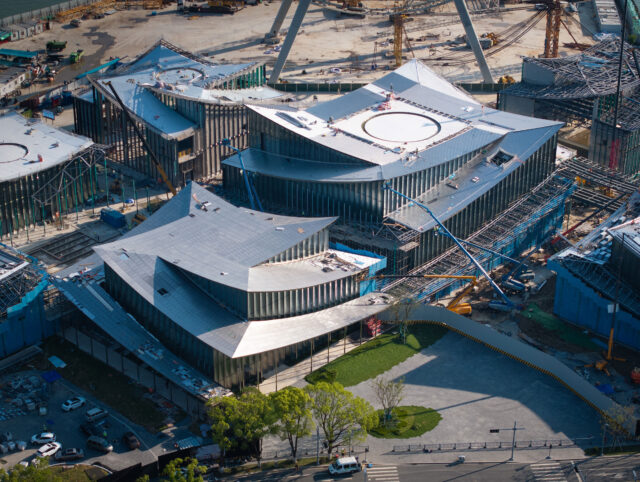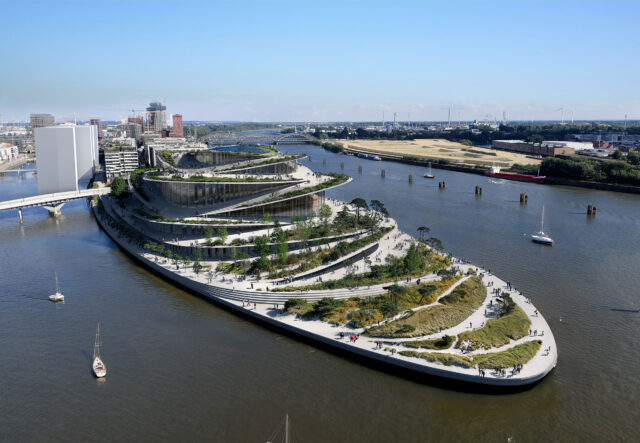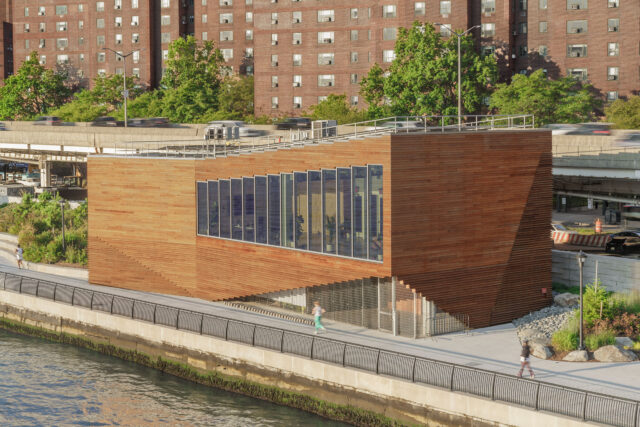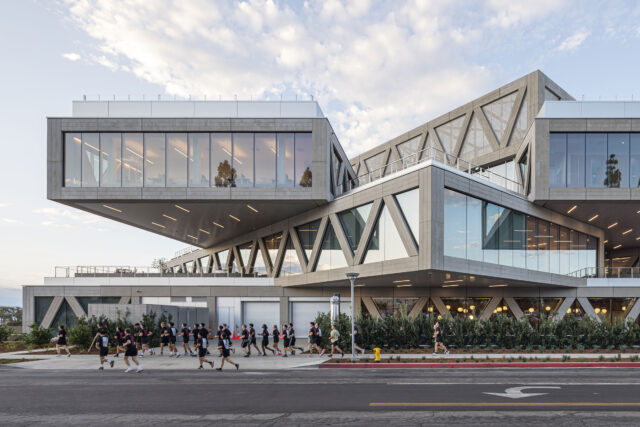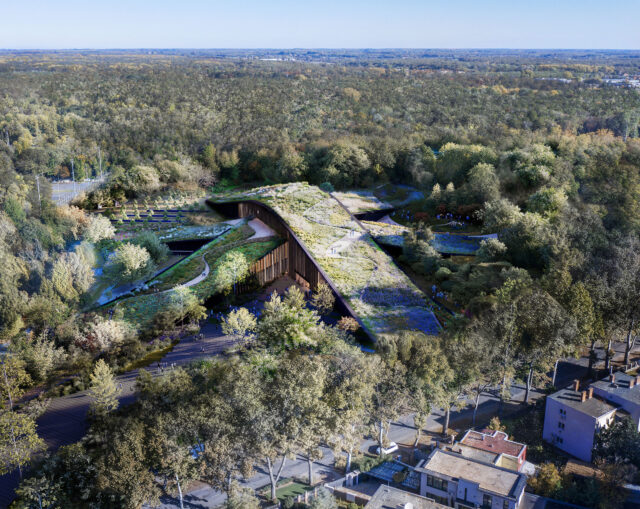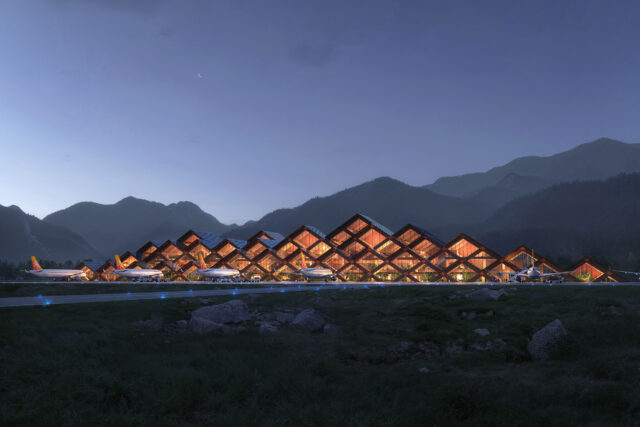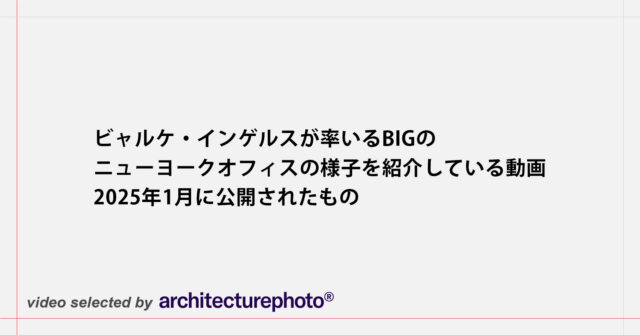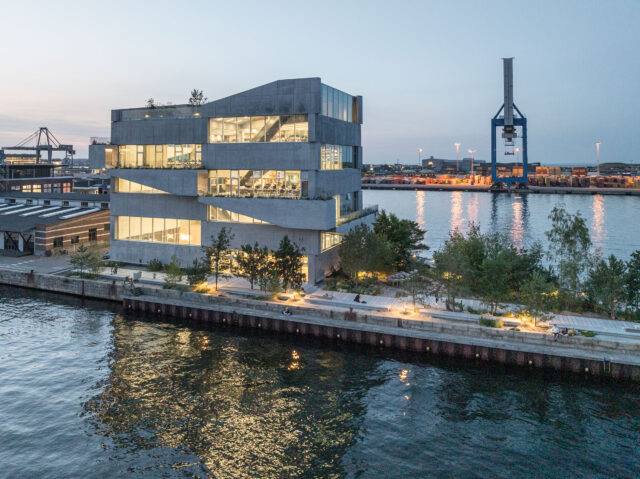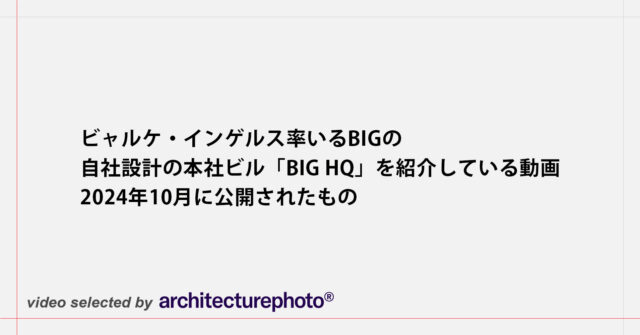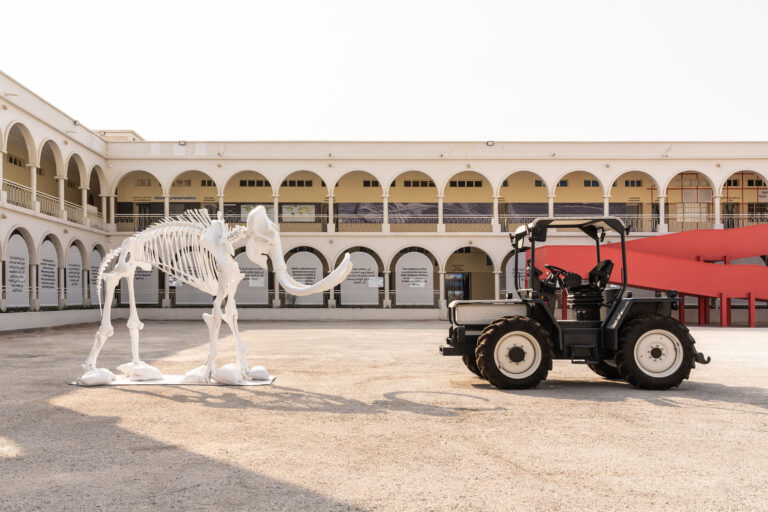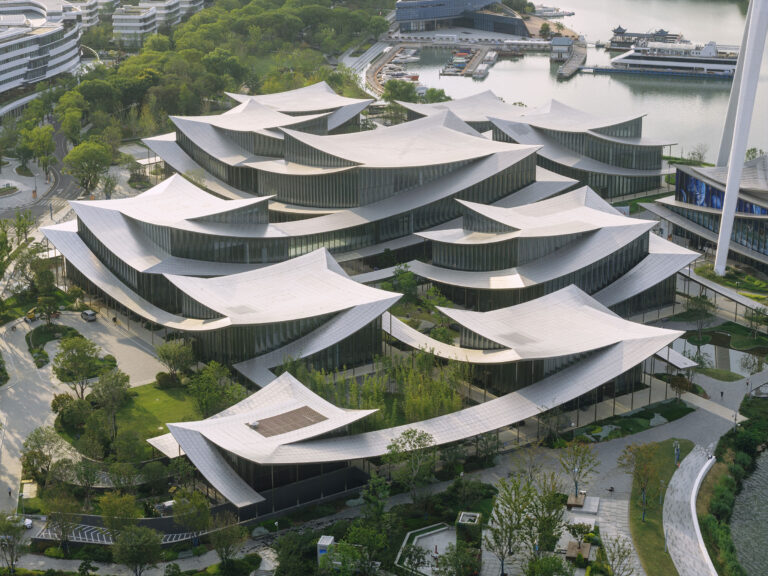
SHARE BIG・ARTS Group・Frontによる、中国の「蘇州現代美術館」。中国庭園の発祥地の湖畔に建つ美術館。地域の庭園の伝統に根ざした存在を求め、屋根付きの回廊“廊”を再解釈する計画を志向。連続する緩やかな屋根の下に複数のパヴィリオンを相互接続する建築を考案




BIG・ARTS Group・Frontによる、中国の「蘇州現代美術館」です。
中国庭園の発祥地の湖畔に建つ美術館です。建築家は、地域の庭園の伝統に根ざした存在を求め、屋根付きの回廊“廊”を再解釈する計画を志向しました。そして、連続する緩やかな屋根の下に複数のパヴィリオンを相互接続する建築を考案しました。正式な開館は2026年を予定しています。アーキテクチャーフォトでは、施工中の様子も特集記事として公開していました。
こちらはリリーステキストです(翻訳:アーキテクチャーフォト / 原文は末尾に掲載)
プレビュー:BIGがキュレーションする展覧会とともに蘇州現代美術館が間もなく完成
BIGが設計した蘇州現代美術館(Suzhou MoCA)は、「マテリアリズム」展の開催に向けて間もなく一般公開されます。リボンのような屋根の下に12のパビリオンが並ぶ村として構想されたこの60,000㎡の美術館は、何世紀にもわたって蘇州の都市形成、建築、景観を形づくってきた庭園要素を現代的に解釈しています。BIGがキュレーションする「マテリアリズム」展は、来場者を石から始まりリサイクル素材で終わる素材の旅へと誘います。
蘇州ハーモニー・ディベロップメント・グループの委託を受け、ARTSグループおよびFront Inc.との協働によりBIG(ビャルケ・インゲルス・グループ)が設計した蘇州現代美術館(Suzhou MoCA)は、現代アート、デザイン、そして中国における公共生活の新たな拠点として金鶏湖の湖畔に位置しています。この美術館は2026年に正式に一般公開される予定です。
この美術館の建築は、道筋をたどる長く屋根のある回廊「廊(ラン)」を再解釈することで、蘇州の庭園の伝統に根ざしています。瓦屋根の輪郭を想起させる緩やかな起伏をもつ連続した屋根の下に、10の相互に接続されたパヴィリオンが統合されています。残る2つのパヴィリオンは来年建設され、金鶏湖の上に張り出す形で設けられ、屋根付きの通路を通じて主要構造と接続されます。
「蘇州は中国庭園の発祥の地です。蘇州現代美術館のための私たちの設計は、パヴィリオンと中庭から成る庭園として考えられています。各パビリオンはガラス張りのギャラリーや柱廊によって織り合わされ、相互につながる彫刻の中庭と展示空間による中国結びをつくりだしています。観覧車の脚の間を縫うようにして、美術館は地下茎のように広がりながら、都市と湖をつないでいます。その結果は、植物とアート作品による、その中で迷うことができる人工の迷路です。その結節状のロジックは、上空のゴンドラから見たときにはじめてはっきりと認識できます。湖の開けた空間を背景に、屋根の緩やかな円錐形の曲線が、水辺に優美なシルエットを描き出しています。上空から見ると、ステンレスの屋根瓦が真の第五のファサードを形作っています」– ビャルケ・インゲルス、BIG 創設者 兼 クリエイティブ・ディレクター
波打つ曲面ガラスと温かみのある色調のステンレス鋼で覆われたファサードは、周囲の空や水、庭園を映し出し、建築と自然環境の境界を曖昧にしています。パヴィリオン同士は地上および地下で橋やトンネルによって接続されており、季節や展示に応じて動線を調整できる柔軟性を美術館にもたらしています。これらの部屋が一体となって一連の庭園や中庭を形作り、訪れる人々をアート、歴史、自然、水が交錯する旅へと導きます。
美術館に到着すると、訪問者はヴィジターセンター前の広々とした広場に迎えられます。ここから来館者は館内へ進むことも、金鶏湖へと延びる遊歩道をたどりながら敷地内を散策することもでき、その様子は蘇州の観覧車から上空から眺めることができます。
館内では、天窓や高窓を通して自然光が差し込み、影と反射の戯れによって展示空間に生命を吹き込んでいます。美術館のパビリオンのうち4棟は主な展示空間を構成しており、残りのパビリオンには大規模なエントランススペース、多目的ホール、シアター、レストランが含まれます。館内には一本の連続した通路があり、来館者を案内しながら、各展示室の間で小さな経路へと分岐していきます。
この美術館のランドスケープデザインは、一連の相互に連結された庭園を通じて、金鶏湖沿いに来訪者を迎える公共空間を創出しています。来館者が水辺に近づくにつれて、庭園は舗装エリアから緑地へ、そして最終的には水をテーマにした植栽へと徐々に変化し、美術館から陸地、湖へと続く自然な流れを反映しています。
中国のGBEL二つ星グリーンビルディング認証の取得を目指して設計された蘇州現代美術館は、パッシブシェーディング、自然換気、地域調達された素材を取り入れることで、都市の文化的ランドマークを創出しています。
「マテリアリズム」展は、ビャルケ・インゲルスの1年間にわたるイタリアのデザイン誌『ドムス』でのゲスト編集長としての務めを発展させたもので、同誌では各号ごとに1つの素材に焦点が当てられていました。この展覧会では、石、土、コンクリート、金属、ガラス、木材、布、プラスチック、植物、リサイクル素材がそれぞれどのようにこの事務所の建築を形作っているかを探ります。BIGのコペンハーゲン本社、デンマーク海洋博物館、Googleベイビュー、The Plusなどを含む20のプロジェクトの大型モックアップや模型が展示され、鑑賞者はBIGの作品を特徴づける触感的・空間的な特性を体験することができます。
ギャラリー全体に設置された座席は、展示されている素材そのもので作られており、質感と形を通じて五感を巡る体験を生み出しています。各セクションの表示板は、それぞれに対応する素材から作られており、黄錆石、版築、テラゾーなどが含まれています。これにより、物質の多様な表現と可能性がさらに明らかにされています。
蘇州現代美術館(Suzhou MoCA)は、ノルウェーのキステフォス彫刻公園にあるThe Twist、スイスのミュゼ・アトリエ・オーデマ・ピゲ、デンマークのレゴ・ミュージアムなどを含む、BIGの文化プロジェクト群のポートフォリオに加わるものです。「マテリアリズム」展は、Yes Is More(2009年)、Hot to Cold(2015年)、Formgiving(2019年)といったBIGのこれまでの展覧会に続くものです。「マテリアリズム」展は、2026年に予定されている蘇州現代美術館の正式開館に先立ち、今後数か月のうちに一般公開される予定です。
以下の写真はクリックで拡大します
























以下、建築家によるテキストです。
PREVIEW: SUZHOU MUSEUM OF CONTEMPORARY ART TO COMPLETE SOON WITH EXHIBITION CURATED BY BIG
The Suzhou Museum of Contemporary Art (Suzhou MoCA) designed by BIG will soon open its doors to the public for the exhibition, Materialism. Conceived as a village of 12 pavilions under a ribbon-like roof, the 60,000-m2 museum offers a modern interpretation of the garden elements that have defined Suzhou’s urbanism, architecture, and landscape for centuries. Materialism, curated by BIG, will take visitors on a material odyssey starting from stone and ending with recyclate.
Commissioned by Suzhou Harmony Development Group and designed by BIG-Bjarke Ingels Group in collaboration with ARTS Group and Front Inc., Suzhou MoCA is located along the Jinji Lake waterfront as a new venue for contemporary art, design, and public life in China. The museum will officially open its doors to the public in 2026.
The architecture of the museum is rooted in the tradition of Suzhou’s gardens by reimagining the ‘lang’ 廊- a long, covered corridor that traces a path. Ten interconnected pavilions are unified beneath a continuous roof whose gentle undulations recall the silhouette of tiled eaves. The remaining two pavilions will be built next year, extending over Jinji Lake and linking to the main structure via covered pathways.
“Suzhou is the cradle of the Chinese garden. Our design for the Suzhou Museum of Contemporary Art is conceived as a garden of pavilions and courtyards. Individual pavilions are woven together by glazed galleries and porticoes, creating a Chinese knot of interconnected sculpture courtyards and exhibition spaces. Weaving between the legs of the Ferris wheel, the museum branches out like a rhizome, connecting the city to the lake. The result is a manmade maze of plants and artworks to get lost within. Its nodular logic only becomes distinctly discernible when seen from the gondolas above. Against the open space of the lake, the gentle conical curvature of the roofs forms a graceful silhouette on the waterfront. From above, the stainless roof tiles form a true fifth facade.” – Bjarke Ingels, Founder & Creative Director, BIG
Clad in rippled and curved glass and warm-toned stainless steel, the facades reflect the surrounding sky, water, and gardens – blurring the boundaries between architecture and the natural environment. The pavilions are connected above and underground via bridges and tunnels, offering the museum flexibility to manage circulation according to seasons and exhibitions. Together, the rooms frame a sequence of gardens and courtyards, guiding visitors on a journey that intertwines art, history, nature, and water.
Arriving at the museum, visitors are welcomed by an expansive plaza in front of the Visitor Centre. From here, museumgoers can proceed inside or explore the grounds, meandering along the walkways that extend out into Jinji Lake, which can be seen from above while on the Suzhou Ferris wheel.
Inside, natural light enters through clerestories and skylights, animating the galleries with a play of shadow and reflection.
Four of the museum’s pavilions comprise the main gallery experience, while the remaining pavilions include a grand entrance space, multifunction hall, theater, and restaurant. A continuous path guides visitors through the museum, branching off into smaller routes between the galleries.
The museum’s landscape design creates a welcoming public space along Jinji Lake through a series of interconnected gardens. As visitors approach the waterfront, the gardens gradually transition from hardscape to greenery to finally water-themed plantings, reflecting a natural progression from museum to land to lake.
Designed to achieve China’s GBEL 2-Star Green Building certification, Suzhou MoCA integrates passive shading, natural ventilation, and locally sourced materials to create a cultural landmark for the city.
The Materialism exhibition expands on Bjarke Ingels’ year-long guest editorship of Italian design magazine Domus, where each issue focuses on a single material. The exhibition explores how stone, earth, concrete, metal, glass, wood, fabric, plastic, plant, and recyclate each shape the firm’s architecture. Large-scale mock-ups and models of 20 BIG projects, such as the studio’s own Copenhagen headquarters, the Danish Maritime Museum, Google Bay View, and The Plus, invite viewers to experience the tactile and spatial qualities that define BIG’s work.
The seating throughout the galleries is made of the very substances on display, creating a full sensory journey through texture and form. Each section’s plaque is crafted from its corresponding medium – including yellow rust stone, rammed earth, and terrazzo – further revealing the varied expressions and possibilities of matter.
Suzhou MoCA joins BIG’s portfolio of cultural projects around the world, including The Twist at Kistefos Sculpture Park in Norway, the Musee Atelier Audemars Piguet in Switzerland, and the LEGO Museum in Denmark. Materialism follows BIG’s previous exhibitions, including Yes Is More (2009), Hot to Cold (2015), and Formgiving (2019). The Materialism exhibition will open to the public in the coming months, ahead of the official opening of the Suzhou Museum of Contemporary Art in 2026.
■建築概要
PROJECT FACTS
Name: Suzhou Museum of Contemporary Art
Size: 60,000 m2
Location: Suzhou, Jiangsu, China
Client: Suzhou Harmony Development Group Co. Ltd
Collaborators: ARTS Group Co., Ltd., Front Inc., Shanghai Shuishi Landscape Design Co., Ltd, Rdesign International Lighting
───
PROJECT TEAM
Partners-in-Charge: Bjarke Ingels, Catherine Huang
Project Manager: Molly Hsiao Rou Huang
Project Architect: Tyrone Cobcroft, Kekoa Charlot, Tseng-Hsuan Wei
Design Lead: Matteo Pavanello
Team: Aileen Koh, Amanda Lima Soares Da Cuncha, Arda Ozker Cincin, Athena Morella, Chih-Han Chen, Christian Vang Madsen, Cris Guoyu Liu, Desislava Georgieva, Eddie Can, Eric Wen Tung Li, Federico Martinez De Sola Monereo, Filip Fot, Filippo Cartapani, Finn Norkjaer, Haochen Yu, Huiyao Fu, Izabella Banas, Jakub Kulisa, Jan Magasanik, Jana Semaan, Jason Cheuk Hei Lee, Jiaqi Yang, Jiawen Huang, Julia Wilkosz, Jurica Pajic, Mathis Paul Gebauer, Megan Nhat Xuan Dang, Narisara Ladawal Schroder, Ole Elkjaer-Larsen, Oliver Steen, Paula Domka, Pei Huang, Philip Kaefer, Phoebe Cowen, Riad Tabbara, Romain Thijsen, Shu Du, Sol Anaid Chaocon Levin, Tarek Shater, Todor Todorov Rusev, Tomasz Jakubowski, Xavier Thanki, Yanis Amasri Sierra, Yihan Liu, Yingying Guan, Zahra Khademi, Zhonghan Huang, Zuzana Faskova
───
BIG Engineering: Andrea Hektor, Adele Scampoli, Alexander Gale Heiede, Andreas Bak, Bjarke Koch-Orvad, Cristina Minguela, Ingrid Albina Oliva Lampa, Janis Bronka, Jens Max Jensen, Jesus Fernandez Lindqvist, Jonathan Russell, Kannan Selvaraj, Konstantinos Koutsoupakis, Maria Capuozzo, Miles Treacy, Thomas Lejeune, Tim Christensen
───
MATERIALISM EXHIBITION PROJECT FACTS
Name: Materialism Exhibition
Location: Suzhou Museum of Contemporary Art, China
───
MATERIALISM EXHIBITION PROJECT TEAM
Partner in Charge: Bjarke Ingels, Kai-Uwe Bergmann, Jakob Lange, Cat Huang
Project Manager: Tseng-Hsuan Wei
Design Lead: Soren Martinussen, Yongwon Jo, Haochen Yu
Team: Shu Du, Claudia Bertolotti, Devanga Phukan, Dora Jiabao Lin, Futa Oba, Guanxin Luo, Jean Kekoa Charlot, Jeronimo Idarraga, Keyao Liu, Matteo Pavanello, Paula Madrid, Siyu Tian, Xiaomeng Chi, Yingying Guan

